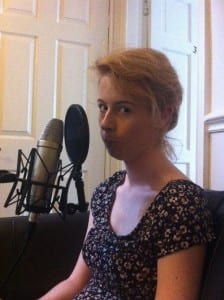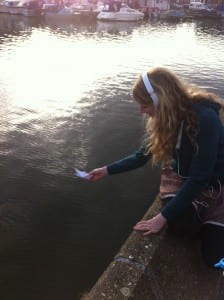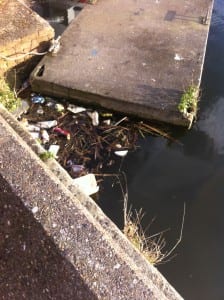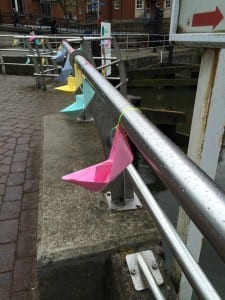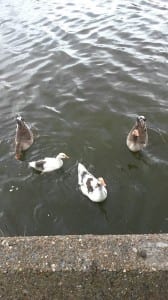A new way of thinking
“Site-specific performance engages with site as symbol, site as a story-teller, site as a structure” (Pearson, 2010) In order to create and perform a truthful and unique performance it was necessary to understand what Site-specific is; I had to consider not only how to connect with a site but how to make that site connect on a new level with an audience. Using a place as a performance space requires research and time; I felt it was important that I personally understood the depth of the history of the site so I could then get an audience to have that same personal connection. Research into different ideologies and explanations relating to Site-specific performance eventually enabled me to come to my own conclusion about what it was.
My understanding of Site-specific is that it is a performance held in unique public locations which invite the audience to connect with something they would normally take for granted. Armed with this basic understanding, my group began to assemble the task by combining our choice of location with the themes of liberation and technology. We opted to perform our work on Brayford Wharf as it was a site we knew little about despite walking on it almost every day. Water and technology may be regarded as being incompatible so, I wanted to find a way to make them harmonious since technology is very much part of our culture and a robust form of communication. We decided to create an audio experience for our audience which would communicate the origins of the waterfront and how it has been manipulated over time. To inform our performance, the group were inspired by works such as “Ports Of Call”-Toby Butler, “The Carrlands project” – Mike Pearson, “Sit with me and remember” – Michael Pinchbeck and “Our Broken Voice” – Artist Collective Circumstance. We each took time to listen and think about how these successful audio performances were structured, spoken and how the site was re-imagined. I was enthused by these and found they creatively helped in the production of our final performance “Against the Flow”; they gave me an insight into how a successful audio tour is composed using a script, the spoken word, atmosphere and its connection to the physical world. Merely having audio and a location however, would not be enough; we wanted the audience to have moments of physical contact with the site so we took inspiration from the Brayford itself, the wildlife in and around it and the assorted boats. We felt our participants would enjoy placing their own mark on this site in different ways so first, they would watch a paper boat being constructed, secondly they would feed the local wildlife and finally, be given a paper boat to launch in the water. They would do all this whilst walking in the opposite direction to the flow of the water hence the title “Against the Flow”.
Refection’s in the Water
Creating a site specific performance was not a process that came naturally to me and I initially found myself confused and fumbling around for inspiration. The problem I faced was not knowing how to communicate with a site ie Brayford Warf, in order to craft a well-rounded performance. The decision to use the waterfront to stage our performance came from our desire to unlock the secrets this waterway may hold, and how this seemingly unchanging pool of water has being moulded and reinvented over time. I felt a good starting point for me would be to visit the site and study everything from its surroundings to the different angles of the water and how that change of view altered my perspective. I tried to look beyond its everyday familiarities and notice the undetected details in and around the water; then I started to see the way the current changed and how this affected the waves, how the smallest change in light affected the water’s atmosphere and my feelings towards it. I even began to notice the walls and buildings and how they shaped and dominated this small natural haven. To enable an audience to see these little details and how the ugly and beautiful work together in one space, the group needed to learn everything about our site. As we began researching the Brayford Pool, we uncovered a variety of first hand accounts dating back to the 18th century; these offered us an insight into how the buildings surrounding the waterway have developed over the years. “The buildings opposite the car park facing Water Lane are also due for demolition and the site is to be used for redevelopment.” (Creasey, 1967).
Despite our research using the internet and local archives, there was little helpful information and we did not want to just focus on historical facts as it would be impossible to truly connect with our site this way. Instead, we needed to have a personal connection with the location that would animate our final performance; a connection we could pass on to the audience. The group spent some time thinking about water and the happy memories it evoked so, on a visit home, I went for a walk around my local lake for inspiration; it was there that happy memories were re-kindled. “In Britain there is no wilderness, no untouched natural landscape. Every metre is the product of human intervention” (Pearson,2010,93). When walking along the Brayford waterfront it is easy to see how human interference has shaped and changed the environment into what it is today. This once open area of water has decreased in size and depth as humanity has grown and added to it. With this in mind, I found myself at Newmillerdam remembering how this very familiar manmade expanse of water had changed over the last 20 years and its similarity to the Brayford. I have been visiting this dam my whole life and have many emotional connections with the area however, it was on this last visit that my whole perspective was changed. I took the same old path and breathed in the fresh air which my mother always advocated would ‘clear the mind and help with unwell feelings’ despite the fact it was always cold and windy. As I approached the water’s edge however, I found myself transported back to Lincoln; the colour of the water, the smell, the swans, the wildlife and the ripple in the waves was practically identical; the only difference was the surroundings. It was at this point that the sun broke through the clouds and made the water shimmer and, just for a second, the memories of the most important man in my life, my grandfather, came flooding back. I spent many a happy day at this location with him, feeding the ducks, searching for frogs and just enjoying the water as a whole however, as I stopped reminiscing, I realised that this memory connection with the water does not have to be restricted to an actual place. If what you are observing has every attribute of what you can remember, who is to say you cannot transport that memory to your current location and relive the happy emotions in a new place. If water is ever changing, then you could be looking at water from that memory and not even recognise it.
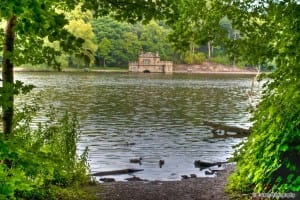
http://static.squarespace.com/static/50f09dcae4b0a42e43ea565e/50f09f1ee4b0e9eeb39bf889/50f09ff8e4b0e9eeb39c110b/1357946872264/NewMillerDam-2.jpg?format=original
As promised, the fresh air had cleared my mind and I found the link I needed to take with me to my site performance. Even though this was not Brayford Warf, their similarities were tangible and invoked strong feelings which could easily come through in our performance. I realised then how important it is to work in a space other than the theatre; you never know who will participate and if they are connected to the place yet the performance must respect its physical and unseen history. “the work of site-specific performance is not to excavate the hidden truth or essence of a location but instead to activate the inherent multiplicity of site”(Theron, 2012, 279).
Music to my Ears
Our most important group decision was that we wanted our final piece to be an audio experience; for the performance to be more intimate; a casual conversation that draws the audience closer to our site through our combined voices. This would be more enthralling and delicate for the participant, and would give them the opportunity to make their own connection with our guidance. With audio now being the key point of focus, we began researching different practitioners and previous performances that would help us successfully create an audio tour; my area of research was the Carrlands Project by Mike Pearson. This audio tour was based around a series of 3 compositions that take you on a journey through North Lincolnshire’s Ancholme Valley. I listened intently to how this particular piece was structured and how the balance between sounds and spoken text was achieved. I found this particular piece dark with an uneasy atmosphere, but the other group members had different experiences with Ports of Call – Community Project and Sit With Me For A Moment And Remember – Michael Pinchback. Their contrasting views were helpful when deciding how we wanted the final performance to feel to the audience. To give authenticity to the piece, we decided to use real life stories by Ron Dadswell, an experienced sailor, and incorporate the sound effects of natural flowing water in between the spoken text so the participant would have quiet moments to reflect upon the whole experience.
(Mudd, 2015)
Crafting Letters
Unfortunately, due to some personal issues, I had some periods of absence when I could not be with the group when they were constructing the script however, I always maintained contact and kept myself involved by having the script sent to me to add to and look over. I undertook my own research on the internet and in my local library and, when I returned to university, I was able to understand the script’s progress. My group found it difficult to structure the text in a way that was informative yet conversational, so we turned again to previous work for inspiration. A Hackney 4th of July By Conan Lawrence and Mark Hunter really helped us to improve the way we could give informed instructions through audio; we paid close attention to the way in which they spoke to the audience; it was as if we were stood beside them. I personally learnt that it was not just the way you structure the words on paper, but about how you actually speak and record those words to make the history come to life in the participants’ eyes. We also found it useful to incorporate some nautical language into our text as it reinforced the connection with the water when describing the land around it.
Speaking a foreign language
Having completed our script for ‘Against the flow’, it was time to create the first draft recording of our audio experience. Taking the microphone, I felt completely unfazed about the task ahead of me; we had a script, the equipment and therefore the voiceover should be a breeze. I was in for a very big surprise. The first challenge I encountered was actually speaking the written text; some of the sentences were poorly composed and the structure was clearly wrong so, as a group, we sat down and rewrote the text as I spoke it through in order to correct our mistakes. Another challenge I encountered was with my Yorkshire accent because, when we listened to the recording, we found some sections had loud rushes of wind and sharp vocals that only occurred because of my way of pronouncing B and P; this was particularly problematic when the water I was constantly referring to throughout the piece was the Brayford Pool. The biggest challenge I faced however, was how to present my vocals on the recording. The purpose of our piece was to change the audiences’ perception of the waterfront by offering them an alternative perspective on it that they had probably never considered. This could be completely ruined by the wrong representation of the voice. My first attempt at the recording sounded like a storybook or a relaxation tape not an immersive and informative piece so, taking this on board, I listened to and researched a variety of audio tours in order to better understand how to improve the quality of my voice for our performance. “Walking accompanied by the taped stories that capture and recall events that happened at specific places in the city, creates an opportunity to see and interrogate the city as a chronotope, charged with traces of the past, personal experiences, affective qualities, and social regimes” (Hahn, 2014, 29) ‘50 Kilometres of Files’ by Haug, Kaegi and Wetzel is an audio walk that was created by Rimini Protokoll and takes place in central Berlin. What I found most fascinating about this performance was, that despite the fact it was spoken in German, which I did not understand, the way in which the people were speaking made me realise that it is not necessary to stage a descriptive voice in order for the piece to be interesting. It is more effective if you speak naturally because the listener then gets a stronger sense of the raw emotion of the piece. It was very obvious just from the tone of the voice when the text was serious, sad or happy and when they wanted the listener to feel part of the history of a place. Emotionally, there was no language barrier and it gave me something to think about when trying to create this personal vocal and audio connection in our Piece. If people who do not understand the language yet can understand the emotions then it opens up the experience and its accessibility. I was also inspired by two very different audio tours namely ‘Our broken voice’ by Artist Collective Circumstance (Dovey and Fluemont, 2012) and ‘The Carrland’s Project’ by Mike Pearson (Pearson, 2007). These audio tours confirmed just how important the voice is as both were targeting a different emotional response. In ‘Our broken voice’ the listener is made to feel quiet, unsafe and excited as these adrenaline fired feelings bring the story to life. ‘The Carrland’s Project however, produced feelings of fear and uncertainty that took the listener into the depths of the history where every step became cautious and real. From these, I realised that the group needed to decide what kind of atmosphere and emotions we wanted to convey to our audience so the right voice would be used; our final decision was for it to be relaxed and enjoyable.
Kerry McCarthy (2015) Against the Flow. [Performance] Lincoln: 74 Newland Street West, 20 March.
Testing the Waters
The 27th of March 2015 was the test run of our first recording of ‘Against the flow’. Naomi and Rachel listened to the audio whilst I walked the course, acting out the place of each person within the piece that the audience would encounter. I found the test run extremely useful as it gave me an insight into how the piece would work whilst interacting with the site. The end of the piece required some modifications such as we needed a bigger gap to walk from the central point to the end point as the audio was ahead of us. We also found that when launching the paper boat, the area we chose caused it to float into a collection of rubbish because of the wind direction thus ruining the poetic ending we intended. Thankfully, the audio could be easily edited, but the wind’s effect on the water was not something we could ever predict.
Rachel Mudd and Paper Boat (2015) Against the Flow. [Performance] Lincoln: Brayford Wharf, 27th March.
Paper Boat (2015) Against the Flow. [Performance] Lincoln: Brayford Wharf, 27th March.
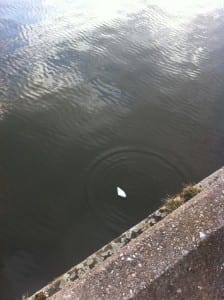
Paper Boat (2015) Against the Flow.[Perfromance] Lincoln: Brayford Wharf, 27th March.
I also discovered that I needed to be very patient as it often took quite some time for the participator to arrive at my allocated area. As a result, I had to stay in a natural performance state no matter how long it took and be ready when the audience arrived to make my contribution to the piece as meaningful as all the others had. I recognised the need to over-feed the wildlife in order to ensure there was always a group of birds around throughout the day; without this temptation, there was the possibility that there may well be no ducks, swans or birds to greet the audience member when they arrived. The site’s natural state had more power over the performance than we anticipated so this was a challenge we had to face on performance day.
A Wet and Windy Evaluation
Our final performance of ’Against the Flow’ comprised of a variety of positive and negative issues. We had a rota of 6 participants signed up to take part between 10:00am and 2:00pm so we arrived early to set up the site. We made a last minute addition to our outfits in that alongside wearing matching blue jeans and white t-shirts, we purchased some see through macs with rain drops on them to add to the water theme; this decision turned out to be very fortuitous as it rained several times during the performances. We also decided that at the start of the performance where Naomi folds several multicoloured paper boats, she would tie the finished articles to the railings by the Brayford. This was an excellent addendum and I feel worked really well as it added colour and an individuality to the site, whilst giving the audience something physical to interact with and admire in the dark weather. These changes were inspired by the site itself after we considered the weather conditions and the physical look of the site on the day; we wanted to work with the site and its natural condition, not against it. It was interesting to note that each of the audiences’ overall reaction and interactions in the performances was different. Each performance had its distinctive moments for example, some people at my point interacted with the swans and geese whereas others only had pigeons or nothing at all. The weather also changed the experience for the audience which was obviously not as enjoyable if it was raining however, each participant walked away having enjoyed a unique encounter.
Overall, I think the moments that were the most successful in the performance were actually out of our control. The site itself was susceptible to incidents that added to the end product and the wildlife’s uncontrollable nature made the central point a pleasure to perform in and surprised me every time. To improve our audio experience, I would have preferred for it to be set out over several days to see how the change in the environment could have improved the performances. I also feel I should have spent more time redrafting and recording my vocals to ensure the atmosphere and tone were correct. Finally, this experience has taught me the importance of viewing my surroundings more intensely and seeing beyond the physical. I now understand how important it is to make an emotional and physical bond with the site you choose to perform in so that the audience will connect properly with the performance. I am also now more aware that performing in a traditional theatre is much simpler as there is no need to understand the stage, its history or its values. When crafting a piece in the outside world however, you must respect it, learn about it and see it for what it truly is before a respectful, informative and unique performance can take place.
Boats and a Sign (2015) Against the Flow. [Perfromance] Lincoln: Brayford Wharf, 7th May.
Paper Boats (2015) Against the Flow. [ Perfromance] Lincoln: Brayford Wharf, 7th May.
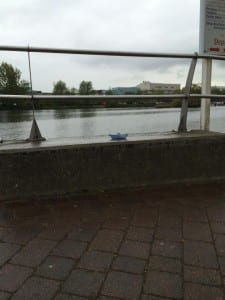
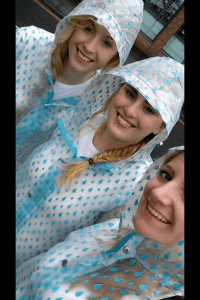
Paper Boat (2015) Against the Flow. [ Performance] Lincoln: Brayford Wharf, 7th May.
Kerry McCarthy, Naomi Jones and Rachel Mudd (2015) Against the Flow. [Perfromance] Lincoln: Brayford Wharf, 7th May.
Ducks (2015) Against the Flow.[Performance] Lincoln: Brayford Wharf, 7th May.
Bibliography
Creasey, J.S. (1967) Brayford Pool Lincoln. Lincoln
Dovey, J. and Fluemont, C. (2012) The Pervasive media cookbook.[Online] Bristol: Available from http://pervasivemediacookbook.com/kitchen/ [Accessed 30 March 2015]
Hahn ,D.(2014) Perfroming Public Spaces, Staging Collective Memory. 50 Kilometres of Files by Rimini Protokoll, 27-38.
Hall, T., Cooper, E., Cunningham, C., Haley, P. (1983) Lincoln’s Waterways – Trail 1. England: Hainton Printing Centre Limited
Haug, H., Kaegi, S. and Wetzel, D. Rimini Protokoll. [Online] Berlin: Available from http://www.rimini-protokoll.de/website/en/projects_date.php [Accessed 30 March 2015]
Laidler, K.J. (1989) Brayford Wharf North: Opportunities for Development. Lincoln.
Lawrence, C. and Hunter, M.(2009) A Hackney 4th of July. [Online] London: Available from http://eprints.lincoln.ac.uk/11846/1/AH4oJRecord.pdf [Accessed 18 May 2015]
Lincoln: The Brayford Study. Edinburgh: Mackenzie and Storrie Ltd
McCarthy, K. (2015) Against The Flow Introduction [Personal Recording] Introducing Against The Flow, 20 March.
Mudd, R. (2015) Against The Flow Interview [telephone call] Conversation with Ron Dadswell, 17 March
Pearson, M.(2007) Carrlands.[online] Cardiff bay: Design Stage. Available from http://www.carrlands.org.uk/default.asp [Accessed 30 March 2015]
Pearson, M. (2010) Site Specific Performance. New York: Palgrave Macmillian.
Sotelo, L. (2010) Looking backwards to walk forward walking, Collective memory and the site of the intercultural in site specific performance. Performance Research, 15(4) 59-69.
Theron, S. (2012) Review. Site Specific Performance, 55(2) 279.
Walker, A.(2012) Brayford Pool: Lincolns Waterfront Through Time. Lincoln: The Survey of Lincoln.University of East London (2008) Ports of Call: Walks of Art at the Royal Docks. [online] London: University of East London. Available From http://www.portsofcall.org.uk/legal.html [Accessed 9th May 2015]

